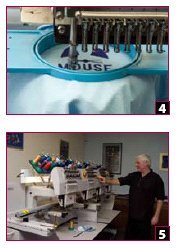articles/Presentation/stitchintime-page1
A Stitch In Time - part 1 of 1
by Mike McNamee Published 01/09/2005

1 The garment is hooped 2 The hoop is accurately located in the sewing machine and the software design is loaded from the host computer 3 The needles swing into action
The need to have a few new polo shirts with the company logo caused me to write some notes on a topic I have been intending to discuss for some time.
There is no doubt that having your logo on a shirt reinforces branding, it is one of the least expensive ways to advertise your name. It also looks slick if you (and your assistant(s)) are in uniform, looking like they belong. There are several ways of going about the task but embroidered wear (not just limited to shirts; you can do caps, blazers, etc) provides the most classy and long-lasting finish.
The cost of embroidery has fallen with the arrival of newer, digital machinery and whereas it used to cost as much as £200 to set up your pattern, you can now get it done for free - indeed at our local supplier, you pay the catalogue price for the garment and everything else is free.
To get some pictures we called on Bernie Gallivan who runs Wirral Textile Motifs (with his wife, Jill) and he took us through the process. You need a clean colour print of your logo up to A4 size (although digital files can be accepted - check with your supplier) and this is fed to the stitch digitising software of the sewing machine. The garment is "hooped" to position the logo and this frame is offered up to the sewing head. From then on it is all automatic, at as many as 1,000 stitches a minute, the colour changes kicking in automatically. If you job runs to hundreds then you are likely to be embroidered on a multi-head machine. For more information call in to your local supplier or email Wirral Textile Motifs at sales@wirraltextilemotifs.co.uk (0151 678 6078).

4 For larger areas, speeds of 1000 stitches per minute are possible 5 Company owner, Bernie Gallivan sets up on their muli-head machine
When designing your logo you could look to Illustrator CS2, just out, and reviewed this issue. It is in logo design that this software excels with its vector precision and point alignment. For even more help look at the new book by Sharon Struer - The Adobe Illustrator CS2 WOW Book (Adobe Press, ISBN 0-321-32046-8 at £35.99). This has always been one of the more inspirational books on using Illustrator and the latest version is no exception. When designing a logo, start by sketching ideas on a blank page. Play with combinations of the letters and mixtures of fonts, looking for an eye-catching combination or variation. If you are looking for a name for your venture at the same time, think about possible web addresses and check their availability (simply type your suggested name in your web browser and if it comes up you are in trouble!). Make sure that, when abbreviated, your company initials don't spell something rude (although it seems to have done French Connection UK no harm!).
Check out your logo in both colour and monochrome, your quote might be faxed or photocopied and passed about at the receiving end, ideally you want it to look good.
Also think about your company stationery and how your logo is going to look at the head of the page - does it project the image you are trying to convey, no point in a quirky cartoon if you are a specialist in corporate portraiture? Once you have a name and logo, print it out a few times and live with it for a week or two, bore your friends with it (but remember, most of your friends will say they like it - find someone who is picky!). One of the advantages of modern digital is that you can print a small number of highly targeted flyers in full colour, double sided and providing they are done well, they can look very classy indeed (don't forget to set your files to "centred " in your printer dialogue to keep both dies in line - less trouble if you have a printer with a "duplex" setting).
You are currently on page 1 Contact Mike McNamee
1st Published 01/09/2005
last update 09/12/2022 14:59:20
More Presentation Articles
There are 0 days to get ready for The Society of Photographers Convention and Trade Show at The Novotel London West, Hammersmith ...
which starts on Wednesday 15th January 2025





